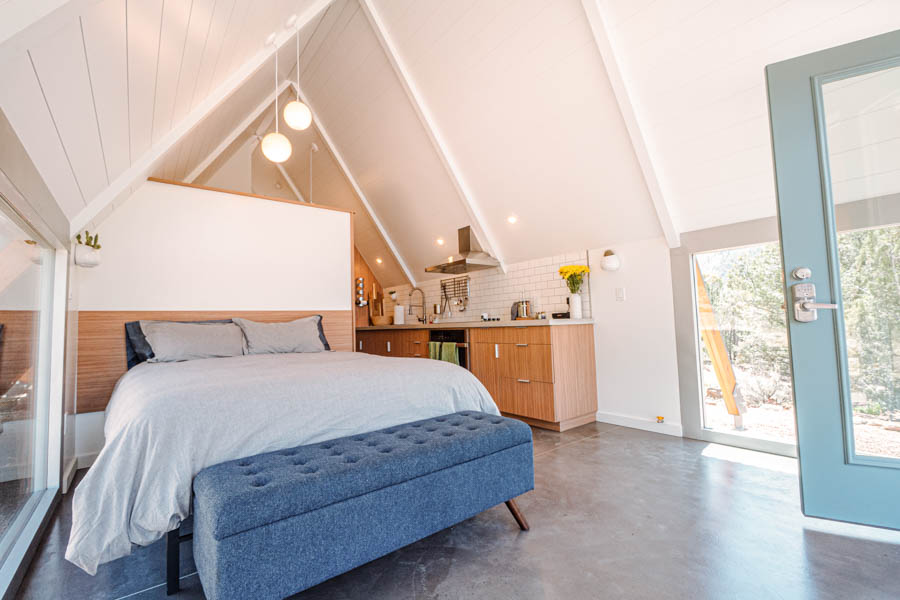- calendar_month August 3, 2023
Accessory dwelling units or ADUs — those separate living units tucked inside a single family home or sharing land with one — are having a rock star moment.
Scores of cities and counties in at least 35 states and the District of Columbia, and at least nine states, including California, have changed or adopted laws that make it easier and more attractive for homeowners to build ADUs.
For many homeowners, ADUs can be a great source of rental income or serve as living quarters for adult children or extended family. They can also be a work-from-home space, or a place to escape to or run a home-based business.
Still, there are still enough challenges involved in building one that ADU author and advocate Kol Peterson said they’re usually undertaken only by homeowners with the motivation, money, knowledge and confidence to see the project through.
For those willing and able to build an ADU, he said, the rewards can be substantial.
What is an ADU?
An ADU can be:
- a newly constructed stand-alone structure
- a home addition that creates a separate living quarter
- conversion of an existing space such as garage or basement into a separate dwelling
We commonly hear ADUs called other names, including in-law apartment, granny flat, casitas or backyard cottage. Once common prior to World War II, many consider ADUs to be a more affordable source of housing. This is because you can build them without having to purchase land. Land is usually the biggest component of housing prices, especially in expensive coastal cities.
“ADUs are still a unique housing type,” said Peterson, who teaches and writes a comprehensive blog on the subject. He’s also authored “Backdoor Revolution: The Definitive Guide to ADU Development,” a book for homeowners considering building one.
Changes in state and local laws could speed up the construction of ADUs and streamline the process for building them.
If you’re thinking about building an ADU, or buying a home with the intention of building an ADU for rental income or multi-generational living, here are some important factors to consider.
Six questions to answer before building an ADU

1. Can I build an ADU on my property?
Before you start sketching layouts and picking paint colors for an ADU, check with your city or county department that oversees planning, construction or zoning to make sure you’re allowed to build, what you’re allowed to build, and where.
Rules around ADUs vary widely across the country, and can vary among cities in the same state. (Peterson maintains an extensive list of some of the cities and states that have adopted ADU regulations at accessorydwellings.org.)
If your home falls under the governance of a homeowners association (HOA), be sure to check the rules there as well.
2. Who can I hire to build an ADU?
If you’re thinking of building an ADU as a DIY project, do a realistic assessment of your skills and how much you’re prepared to take on. While it’s certainly possible to be your own contractor, it requires knowledge, time and coordination.
If you’re the kind of person who loves the challenge and satisfaction of building something from scratch and you’re eager to learn what it takes, you’ve hit the lottery.
Developing land — and this is basically what you’re doing when you construct a new building — requires attention to things you might not anticipate. This includes construction permits, utility connections and scheduling work at the right cadence.
More likely, you can expect to hire professionals to do some or all of the work, including the following:
- Design: An architect and/or engineer to draw up plans. If you’re considering a pre-fab home or a kit, check with your local building department to make sure the home you’re considering meets local building codes. (Some cities, such as Los Angeles, also have standard pre-approved building plans that you can choose from.)
- Construction: A general contractor who can act as conductor for the entire project, or individual contractors who for electrical or plumbing work.
- Site work: Water, power, sewage and grading, if needed.
If you’re hiring professionals, get recommendations from people who can vouch for their work. The Federal Trade Commissions has good tips on what to look for before hiring a contractor.
Interest and growth in ADU development has given rise to companies who bill themselves as one-stop shops for ADUs. Some offer their own models to choose from, which could make it less expensive than building a custom ADU.
If you opt for a pre-fabricated or manufactured home that can be delivered to your property, check with your city or county building department to make sure it meets local building codes.
3. How much does it cost to build an ADU?
As a general rule, ADUs don’t come cheap. Even without the land costs, the cost of construction — and viable ways of paying for it — are limited.
The cost will depend on the size and type of ADU, and the local wages. For instance, the city of San Jose, California — one of the more expensive cities in America — estimates that “a new, custom-built detached ADU may cost as much as $250,000. Retrofitting an existing attached garage or basement may cost approximately $80,000 to $150,000, depending on size, existing plumbing and how you design the space.”
You can save money on the design if you live in a city that offers “pre-approved” building plans that homeowners can use to build their ADU either for free or for a licensing fee. The plans, which can be customized to a degree, speed up the review process because they already meet the city’s building code and design guidelines.
Peterson, the ADU author and advocate in Portland, said that fixed costs in new construction, such as excavation and laying a foundation, make even small ADUs expensive. Given the fixed costs, some homeowners choose to build to the maximum size allowed in their jurisdiction since adding additional square footage is relatively inexpensive.
For example, the average cost to develop a detached 400 square foot ADU in Portland, Oregon, in 2019 was about $170,000; doubling the size to 800 square feet added only about $40,000 to the overall cost, according to Peterson.
That said, some cities or counties charge “impact fees” for larger buildings, so check with your local building department when considering the size of your dwelling.
4. Can I finance an ADU?
Financing can be the hardest part of the process. That’s because the majority of traditional lenders don’t offer loans to construct ADUs. The few that do generally write loans only for work done by professional contractors, Peterson said. And, he said, those loans tend to carry higher interest rates and require mortgage insurance.
“Most people put together a patchwork of sources to pay for it,’’ he said. Those include refinancing to tap into home equity, selling investments, borrowing from friends and family and putting some of the cost on credit cards.
Some funding possibilities include:
- Existing savings
- 401K loan
- Cash-out refinance
- Second mortgage
- Home Equity Line of Credit
- A construction loan
- A renovation loan
- A reverse mortgage
- A ground lease agreement
- Private money
- Shared appreciation
- Shared equity agreement
- Alternative funds through local government or non-profits
5. How might I save on the construction cost of an ADU?
Converting an existing space into a separate living unit is likely to cost less than new construction. Keep in mind, however, that things can get pricey if you choose high-end finishes.
Another way to cut costs is to build a dwelling from plans that have been “pre-approved” by your county or city building department.
Buying a pre-built model or kit home also may offer a way to cut costs. Just be sure to factor in all applicable costs, including utility hookups. Some pre-built models only include the structure itself. You’ll want to factor in the cost of finishing the inside and installing electric and plumbing.
Using doors, cabinets, flooring and windows salvaged from other construction or demolition projects can also help you save money. Check your local business listings to see if there are salvage businesses nearby.
Whatever you decide, you’ll want to make sure the space is inviting. To get an idea of designs that make small spaces seem bigger, check out this video.
6. Calculate the Return on Investment (ROI) in your real estate market
In cities with high housing costs, rental income can pay for the costs of development in a matter of years. Rental income also can provide a homeowner with future options for downsized living without having to move from their home, Peterson said.
Legally permitted ADUs also tend to add value to a property, he said. While ADUs don’t promise instant riches, Peterson said, they can be a good way to build wealth.
Some localities, such as San Mateo, California, have created ADU calculators to help people determine whether area rents will generate enough to cover monthly expenses. Beyond that, there are considerations about what is involved in being a landlord.
Want to learn more about what’s involved in renting out property? Check out Zillow’s Rental Manager.
